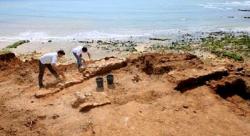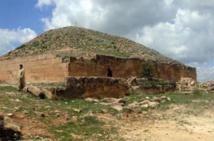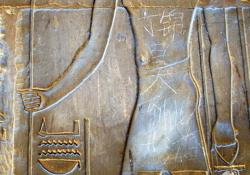INSTITUT SUPERIEUR D'ANTHROPOLOGIE
INSTITUTE OF ANTHROPOLOGY
ONLINE COURSES / COURS A DISTANCE
SUMMER TERM : JULY 2013
REGISTER NOW
PORTUGAL –  Albufeira - “Archaeologists have uncovered a near-complete skeleton dating from the 15th or 16th century on a cliff-top site above the Santa Eulália beach in Albufeira, which is believed to be an important medieval cemetery. The skeleton was buried in an area near the historically-recorded Ermida de Santa Eulália chapel, where a burial ground is thought to have existed. It is not the first time that skeletal remains have been found in this location. However, they have previously been found lying in a north to south position rather than from east to west, as was the case in this recent discovery. But both positions are associated with Christian burial rituals. The arms of the skeleton, believed to be a man, were positioned over its abdominal area and it will be removed from the cliff-top grave to be analysed by archaeologists. The need for a speedy analysis is prompted due to the fact that a cliff stabilisation operation is also underway because of the risk of landslides from recent winter storms. Apart from the unearthing of the skeleton, remains of a factory for the Roman fish-paste known as garum were found. Garum was much appreciated at the time and was exported to other countries.”
Albufeira - “Archaeologists have uncovered a near-complete skeleton dating from the 15th or 16th century on a cliff-top site above the Santa Eulália beach in Albufeira, which is believed to be an important medieval cemetery. The skeleton was buried in an area near the historically-recorded Ermida de Santa Eulália chapel, where a burial ground is thought to have existed. It is not the first time that skeletal remains have been found in this location. However, they have previously been found lying in a north to south position rather than from east to west, as was the case in this recent discovery. But both positions are associated with Christian burial rituals. The arms of the skeleton, believed to be a man, were positioned over its abdominal area and it will be removed from the cliff-top grave to be analysed by archaeologists. The need for a speedy analysis is prompted due to the fact that a cliff stabilisation operation is also underway because of the risk of landslides from recent winter storms. Apart from the unearthing of the skeleton, remains of a factory for the Roman fish-paste known as garum were found. Garum was much appreciated at the time and was exported to other countries.”
http://paigedoerner.wordpress.com/2013/05/27/discovery-of-medieval-cemetery-in-portugal/
INDE –  Chennai:- About 31 heritage temples coming under the control of the state Archaeology department are set for renovation this year. According to sources, about 16 temples including the Sri Mahadevar temple in Kancheepuram district and Kadambavaneswarar temple in Cuddalore district would be taken up for renovation and infrastructure work. Meanwhile, the state archaeology department has taken up the task of copying the inscriptions and digitising them in Salem and Sivaganga district. Already, 24,060 inscriptions from 26 districts have been copied and 10,000 estampages have been digitised. Also, the Government Oriental Manuscripts Library and Research Centre achieved a Herculean task of digitising about 10,000 pages of the Tamil palm leaf manuscripts on various topics. In addition, as part of the National Mission for Manuscripts, the library has digitised 22,750 manuscripts on Tamil culture, astronomy, Siddha, Ayurveda, etc.
Chennai:- About 31 heritage temples coming under the control of the state Archaeology department are set for renovation this year. According to sources, about 16 temples including the Sri Mahadevar temple in Kancheepuram district and Kadambavaneswarar temple in Cuddalore district would be taken up for renovation and infrastructure work. Meanwhile, the state archaeology department has taken up the task of copying the inscriptions and digitising them in Salem and Sivaganga district. Already, 24,060 inscriptions from 26 districts have been copied and 10,000 estampages have been digitised. Also, the Government Oriental Manuscripts Library and Research Centre achieved a Herculean task of digitising about 10,000 pages of the Tamil palm leaf manuscripts on various topics. In addition, as part of the National Mission for Manuscripts, the library has digitised 22,750 manuscripts on Tamil culture, astronomy, Siddha, Ayurveda, etc.
http://www.deccanchronicle.com/130527/news-current-affairs/article/31-heritage-temples-be-renovated
France - Maismont - La deuxième conférence proposée par le musée Alfred-Danicourt, samedi, a permis d'en savoir plus sur la première tranche de fouilles, menée en 2011. « Cette première tranche a porté sur 1,5 des quatre hectares, précise Laurent Duvette, archéologue à l'Institut national de recherches archéologiques préventives Nord-Picardie, qui a animé la conférence en compagnie de Tahar Ben Redjeb, ingénieur d'études et archéologue de la Direction régionale des affaires culturelles. Nous avons découvert une occupation gauloise datant de 450 avant J.-C., ainsi qu'une occupation romaine du Haut-Empire (des I er , II e et III e siècles après J.-C.). À cet endroit se trouvait une ferme gauloise avec des enclos, dont il reste des traces, ainsi que trois édifices construits avec du bois et du torchis. » Des données encore un peu vagues, tout comme celles portant sur l'occupation romaine. « Nous avons observé des fossés correspondant à des enclos et retrouvé de la vaisselle gallo-romaine. Et nous avons pu constater l'absence d'occupation antique tardive. » La seconde campagne de fouille devrait donc avoir tout son intérêt, puisque, comme l'explique l'archéologue, « elle permettra de préciser la chronologie, ainsi que la nature de l'occupation romaine ». Avec encore des découvertes en perspective.
http://www.courrier-picard.fr/region/fermes-gauloises-et-romaines-dans-la-future-zac-de-maismont-ia181b0n91972
ALGERIE –  Tiaret - Classés patrimoine national en 1968, les tombeaux d’Ajdar de Frenda qui sont proposés à l’inscription sur la liste du patrimoine mondial depuis 2002 subissent les effets des facteurs naturels et climatiques qui sont à l’origine de la destruction de 10 tombeaux sur 13, précisant que le dernier tombeau a été détruit durant la guerre de libération. En 2011, un film documentaire de 26 mn a été réalisé sur le sujet et projeté à l’intérieur et à l’extérieur du pays. L’«Association pour la défense et la protection des vestiges de Tiaret», présidée par Hmida Daoud, milite également pour la sauvegarde des biens culturels de Tiaret. Selon le président de l’association, des sites archéologiques importants, à l’instar des tombeaux d’Ajdar, des grottes d’Ibn Khaldoun à Taghazout, du site de l’Emir Abdelkader et autres souffrent de la marginalisation et ont grandement besoin de réhabilitation. Il est à noter que la wilaya de Tiaret compte plus de 452 sites archéologiques, dont cinq ont été classés patrimoine national.
Tiaret - Classés patrimoine national en 1968, les tombeaux d’Ajdar de Frenda qui sont proposés à l’inscription sur la liste du patrimoine mondial depuis 2002 subissent les effets des facteurs naturels et climatiques qui sont à l’origine de la destruction de 10 tombeaux sur 13, précisant que le dernier tombeau a été détruit durant la guerre de libération. En 2011, un film documentaire de 26 mn a été réalisé sur le sujet et projeté à l’intérieur et à l’extérieur du pays. L’«Association pour la défense et la protection des vestiges de Tiaret», présidée par Hmida Daoud, milite également pour la sauvegarde des biens culturels de Tiaret. Selon le président de l’association, des sites archéologiques importants, à l’instar des tombeaux d’Ajdar, des grottes d’Ibn Khaldoun à Taghazout, du site de l’Emir Abdelkader et autres souffrent de la marginalisation et ont grandement besoin de réhabilitation. Il est à noter que la wilaya de Tiaret compte plus de 452 sites archéologiques, dont cinq ont été classés patrimoine national.
http://www.reflexiondz.net/TIARET-Patrimoine-archeologique-a-sauver_a23883.html
EGYPTE –  Louxor - A human figure depicted in relief has suffered serious damages, after a Chinese tourist carved his name on it… The incident took place yesterday in Luxor, Egypt. As reported -and seen through numerous social media- a Chinese tourist named Ding Jinhao decided to “secure his place to eternity” by carving “ Ding Jinhao was here” on an ancient Egyptian relief. The monument of which the relief forms part has not been named although it appears to be Hellenistic in date. According to Chinese bloggers, several tourists attempted to remove the markings themselves, resulting in the white smudge that appears in the photograph above. Shortly after the outrage, Ding Jinhao’s parents issued a statement to Chinese media, apologizing for their son’s action. It is not yet clear whether the markings can be removed in order to safely restore the temple wall to its original state.
Louxor - A human figure depicted in relief has suffered serious damages, after a Chinese tourist carved his name on it… The incident took place yesterday in Luxor, Egypt. As reported -and seen through numerous social media- a Chinese tourist named Ding Jinhao decided to “secure his place to eternity” by carving “ Ding Jinhao was here” on an ancient Egyptian relief. The monument of which the relief forms part has not been named although it appears to be Hellenistic in date. According to Chinese bloggers, several tourists attempted to remove the markings themselves, resulting in the white smudge that appears in the photograph above. Shortly after the outrage, Ding Jinhao’s parents issued a statement to Chinese media, apologizing for their son’s action. It is not yet clear whether the markings can be removed in order to safely restore the temple wall to its original state.
http://www.archaiologia.gr/en/blog/2013/05/27/chinese-tourist-damages-egyptian-relief/
USA –  Camp Lawton - Researchers and archaeology students are getting ready to break new ground this summer at Camp Lawton, a Civil War prison camp that stayed virtually undisturbed for nearly 150 years before it was discovered in southeast Georgia. The sprawling Confederate camp once held more than 10,000 Union prisoners, but it was abandoned just six weeks after opening in 1864. The camp was largely forgotten until a Georgia Southern University archaeology discovered student discovered remains of Camp Lawton's stockade walls in 2010. Since then, more than 600 artifacts have been recovered at the site.
Camp Lawton - Researchers and archaeology students are getting ready to break new ground this summer at Camp Lawton, a Civil War prison camp that stayed virtually undisturbed for nearly 150 years before it was discovered in southeast Georgia. The sprawling Confederate camp once held more than 10,000 Union prisoners, but it was abandoned just six weeks after opening in 1864. The camp was largely forgotten until a Georgia Southern University archaeology discovered student discovered remains of Camp Lawton's stockade walls in 2010. Since then, more than 600 artifacts have been recovered at the site.
http://www.wtoc.com/story/22429251/ga-civil-war-camp-turns-up-hundreds-of-artifacts